Related Research Articles

A boomerang is a thrown tool typically constructed with airfoil sections and designed to spin about an axis perpendicular to the direction of its flight. A returning boomerang is designed to return to the thrower, while a non-returning boomerang is designed as a weapon to be thrown straight and is traditionally used by some Aboriginal Australians for hunting.
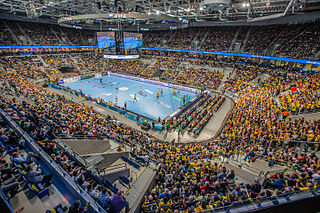
Handball is a team sport in which two teams of seven players each pass a ball using their hands with the aim of throwing it into the goal of the opposing team. A standard match consists of two periods of 30 minutes, and the team that scores more goals wins.

Softball is a sport similar to baseball, and it is played with a larger ball on a smaller field and with only underhand pitches permitted. Softball is played competitively at club levels, the college level, and the professional level. The game was first created in 1887 in Chicago by George Hancock.

Team roping also known as heading and heeling is a rodeo event that features a steer and two mounted riders. The first roper is referred to as the "header", the person who ropes the front of the steer, usually around the horns, but it is also legal for the rope to go around the neck, or go around one horn and the nose resulting in what they call a "half head". Once the steer is caught by one of the three legal head catches, the header must dally and use his horse to turn the steer to the left.
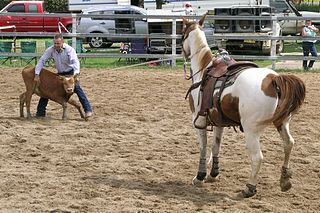
Calf roping, also known as tie-down roping, is a rodeo event that features a calf and a rider mounted on a horse. The goal of this timed event is for the rider to catch the calf by throwing a loop of rope from a lariat around its neck, dismount from the horse, run to the calf, and restrain it by tying three legs together, in as short a time as possible. A variant on the sport, with fewer animal welfare controversies, is breakaway roping, where the calf is roped, but not tied.

Futsal is a football-based game played on a hardcourt like a basketball court, smaller than a football pitch, and mainly indoors. It has similarities to five-a-side football and indoor football.

Track and field is a sport that includes athletic contests based on running, jumping, and throwing skills. The name is derived from where the sport takes place, a running track and a grass field for the throwing and some of the jumping events. Track and field is categorized under the umbrella sport of athletics, which also includes road running, cross country running and racewalking. In British English the term "Athletics" is synonymous with American "Track and Field" and includes all jumping events.

Box lacrosse, also known as boxla, box, or indoor lacrosse, is an indoor version of lacrosse played mostly in North America. The game originated in the 1930s in Canada, where it is more popular than field lacrosse. Lacrosse is Canada's official national summer sport. Box lacrosse is played between two teams of five players and one goalie each, and is traditionally played on an ice hockey rink once the ice has been removed or covered. The playing area is called a box, in contrast to the open playing field of field lacrosse. The object of the game is to use a lacrosse stick to catch, carry, and pass the ball in an effort to score by shooting a solid rubber lacrosse ball into the opponent's goal. The highest level of box lacrosse is the National Lacrosse League.
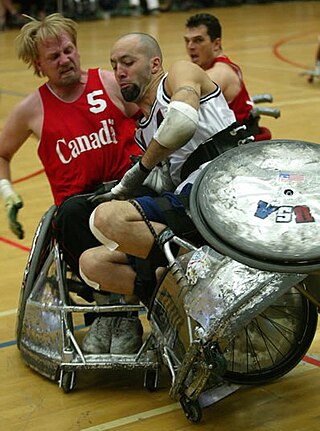
Wheelchair rugby is a team sport for athletes with a disability. It is practiced in over twenty-five countries around the world and is a summer Paralympic sport.

Gridiron football, also known as North American football, or in North America as simply football, is a family of football team sports primarily played in the United States and Canada. American football, which uses 11 players, is the form played in the United States and the best known form of gridiron football worldwide, while Canadian football, which uses 12 players, predominates in Canada. Other derivative varieties include arena football, flag football and amateur games such as touch and street football. Football is played at professional, collegiate, high school, semi-professional, and amateur levels.

Greco-Roman, Graeco-Roman, classic wrestling is a style of wrestling that is practiced worldwide. Greco-Roman wrestling was included in the first modern Olympic Games in 1896 and has been in every edition of the summer Olympics held since 1904. This style of wrestling forbids holds below the waist, which is the main feature that differentiates it from freestyle wrestling. This restriction results in an emphasis on throws, because a wrestler cannot use trips to bring an opponent to the ground or hook/grab the opponent's leg to avoid being thrown.

Freestyle wrestling is a style of wrestling. Along with Greco-Roman, it is one of the two styles of wrestling contested in the Olympic Games. High school wrestling and men's collegiate wrestling in the United States are conducted under different rules and termed scholastic and collegiate wrestling. U.S. collegiate women's wrestling is conducted under freestyle rules.
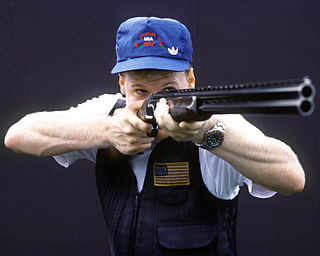
Trap shooting, or trapshooting in North America, is one of the three major disciplines of competitive clay pigeon shooting, which is shooting shotguns at clay targets. The other disciplines are skeet shooting and sporting clays.

A goalkeeper is a position in association football. It is the most specialised position in the sport. The goalkeeper's main role is to stop the opposing team from scoring. This is accomplished by having the goalkeeper move into the trajectory of the ball to either catch it or direct it further from the vicinity of the goal line. Within the penalty area goalkeepers are allowed to use their hands, giving them the sole rights on the field to handle the ball. The goalkeeper is indicated by wearing a different coloured kit from their teammates and opposition.
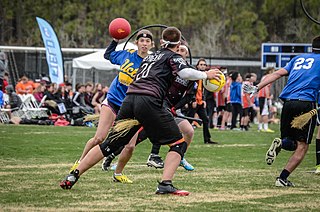
Quidditch, officially known as quadball since 2022, is a team sport that was created in 2005 at Middlebury College in Middlebury, Vermont, United States, and was inspired by the fictional game of the same name in the Harry Potter books by the author J. K. Rowling. Two teams of seven players each, astride broomsticks and opposing each other on a rectangular pitch, compete with the primary objective of passing a ball through the defenders' hoops, while preventing their opponents from passing it through their own hoops. The real-world sport is sometimes referred to as "muggle quidditch" to distinguish it from the fictional game of the books, which involves magical elements such as flying broomsticks and enchanted balls—a muggle in the Harry Potter series being a person without magical abilities. The sport is played around the world.

The men's 100 metre butterfly event at the 2008 Olympic Games took place on 14–16 August at the Beijing National Aquatics Center in Beijing, China.

Throwball is a non-contact ball sport played across a net between two teams of nine players on a rectangular court.
Netball is a ball sport for two teams of seven players; its rules are published in print and online by the International Netball Federation. Games are played on a rectangular court divided into thirds, with a raised goal at each short end. The objective of the game is for teams to score goals, by passing a ball and shooting it into the opposite team's goal ring. Players are assigned "positions" that define their role within the team and restrict their movement on court.

The men's 100 metres competition at the 2012 Summer Olympics in London, United Kingdom was held at the Olympic Stadium on 4–5 August 2012. Seventy-four athletes from 61 nations competed. Each nation was limited to 3 athletes per rules in force since the 1930 Olympic Congress. The competition comprised four rounds: a preliminary round for entrants without the minimum qualifying standard, a heats round, followed by three semi-finals of eight athletes each, which then reduced to eight athletes for the final.
ARW1 is a Paralympic archery classification. It is a sitting class. This class includes Les Autres sportspeople. People from this class compete in the sport at the Paralympic Games.
References
- ↑ Article — Boomerang Competition Events, Boomerang Association of Australia, retrieved 2008-08-26
- ↑ Seattle woman shatters world boomerang record, King5.com, March 4, 2008, archived from the original on September 26, 2008, retrieved 2008-08-26